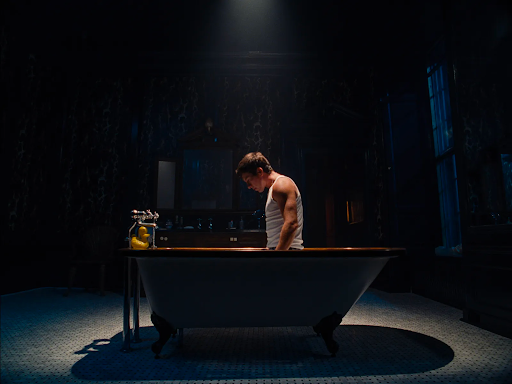Saltburn: Eating the Rich

Ethan Sutton ‘27 / Emertainment Monthly Staff Writer
By now, most people have heard some buzz surrounding Saltburn, Academy Award winner Emerald Fennell’s deliciously crafted sophomore film. It’s the sort of film you know in the first ten seconds will be eye candy. The storyline follows Oliver (Barry Keoghan), a middle-class Oxford University student, who becomes engrossed by the luxurious lifestyle of his aristocratic friend Felix (Jacob Elordi). Felix invites Oliver to his estate, leading to a series of surprising events. Fennell’s fascination with sexual desire, lust, and longing is not new, for it has been explored in her previous works Promising Young Woman and Killing Eve. Saltburn is just the latest addition to her catalog of twisted fascinations. She dresses it with devilish anecdotes that you might not expect from a killer thriller such as this. The movie also features notable performances by Elspeth Catton (Rosamund Pike), Poor Dear Pamela (Carey Mulligan), and Farleigh (Archie Madekwe).
For the most part, Saltburn is a visually stunning film. This is thanks to cinematographer Linus Sandgren. Sandgren has worked on many Oscar-recognized feature films such as La La Land, Don’t Look Up, and No Time To Die. His latest work is just as successful, adjusting the framing to capture the tone of each specific scene. The use and balance of color further enhance the intensity of the story. But the micro-scale interactions and moments of convincing acting made the film most compelling, offering audiences a humanistic perspective on the morals or absence thereof conveyed, rather than presenting a specific moral message. Thus, it offers an insightful exploration of the filthy rich and our captivation with their intangible lifestyle.
Diving deeper into its essence, the film introduces some groundbreakingly shocking visuals that have been catalysts for reactions and comments on social media. For example, there’s a bathtub scene where Fennell shows visceral images of sweat, semen, and menstrual blood. Even though these scenes are graphic, they create a kind of deceptive magic. Adding this raw energy makes Fennell’s thematic exploration more interesting. She not only pushes the boundaries of the conventional psychological thriller aesthetic but also magnifies the narrative’s authenticity. This turns the film into a strong exploration of problems in society, especially among the top 1%.
This is a modern movie, and in today’s age where social media plays a significant role in shaping the conversation around movies, the visuals can create a variety of perspectives. This usually results in the visuals overshadowing the more nuanced intentions and themes underlying the screenplay. The arguments made by critics of Saltburn are primarily due to how it illustrates wealth and desire, rather than emphasizes its satirical elements. This is a modern movie, and in today’s age where social media plays a significant role in shaping the conversation around movies, the visuals can generate a variety of perspectives. This usually results in the visuals overpowering the more nuanced intentions and themes underlying the screenplay. I believe the division over Saltburn results from the provocative visuals and depictions of wealth and desire rather than its satirical elements. These elements take a backseat to the captivating visuals that the film showcases.